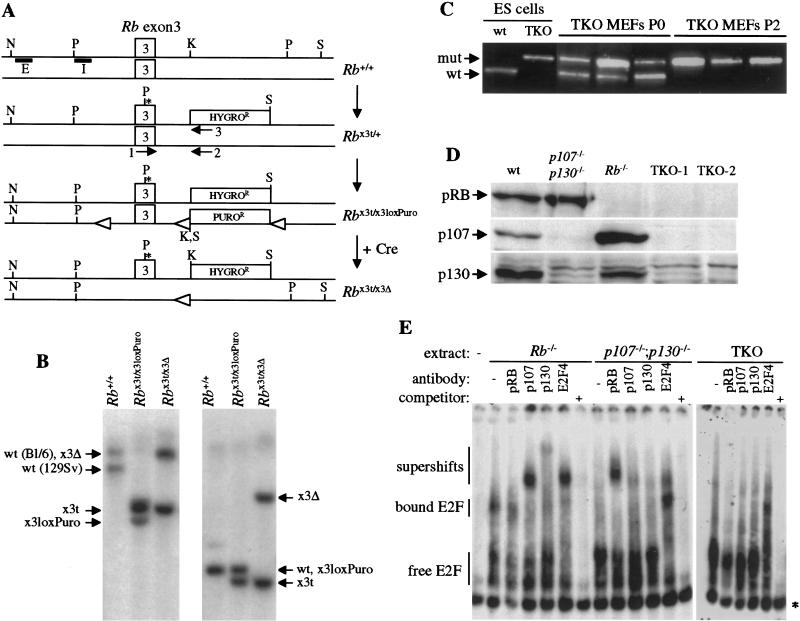Figure 1.
Creation of TKO ES cells and MEFs. (A) Targeting of the first Rb allele in p107−/−;p130−/− ES cells inserted a stop codon (*) in Rb exon 3 and a hygro cassette in intron 3, creating a null allele (Rb×3t). For the second allele, a targeting vector carrying a puro cassette and loxP sites (open triangles) was used (Rb×3loxPuro allele). Upon introduction of Cre, Rb exon 3 was deleted, creating a null allele (Rb×3Δ). The boxes marked E and I represent the two probes used in the Southern blot analysis, and the arrows marked 1, 2, and 3 represent the primers used in the PCR analysis. N, Nco1; P, Pst1; K, Kpn1; S, Sal1. Not to scale. (B) Southern blot analysis of TKO ES cells. Genomic DNAs of p107−/−;p130−/− ES cells with various Rb alleles were digested with Nco1 and Sal1 and hybridized with probe E (left panel) or with Pst1 and Kpn1 and hybridized with probe I (right panel). Arrows indicate alleles. The ES cells are on a mixed C57BL/6x129Sv genetic background, and the Nco1–Sal1 digest provides a polymorphism allowing us to distinguish both Rb alleles. (C) TKO MEF populations purity assayed by PCR. Primers 1–2 and 1–3 amplify Rb wild-type (wt) and mutant (mut) alleles, respectively (Williams et al. 1994). At passage 0 (P0), TKO MEFs are mixed with wild-type MEFs. After selection, at passage 2 (P2), contaminating wild-type cells are absent. Three representative examples of TKO MEF populations are shown, as well as amplification results from control ES cells DNAs. (D) Western blot analysis of the three pRB family members in MEFs bearing different combinations of mutant alleles in Rb, p107, and p130. Two TKO MEF lines from two independent ES cells clones are shown. (E) E2F electromobility shift assays using extracts from exponentially growing TKO and control MEFs. p107 and p130 antibodies shift p107:E2F and p130:E2F complexes in Rb−/− cells, and pRB antibody shifts pRB:E2F complexes in p107−/−;p130−/− cells. In contrast, in TKO cells, no complex is visible or shifted by these antibodies, and only the E2F-4 antibody shifts free E2F.* indicates a nonspecific complex. The probe has been run off the gel for better resolution. Bound and free (in complexes with pRB family or not) E2F are indicated as well as supershifts. When indicated, a 1000 times excess of specific competitor was added in the reactions.

